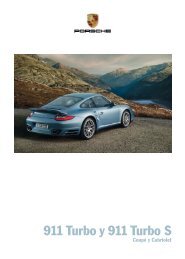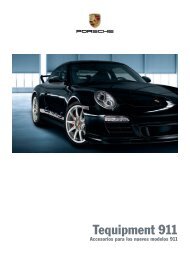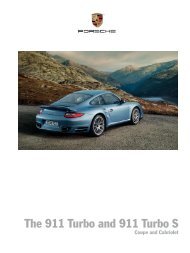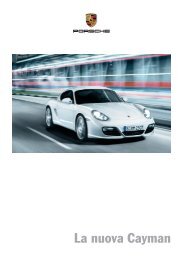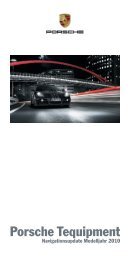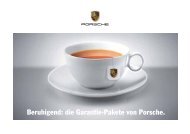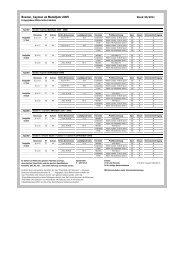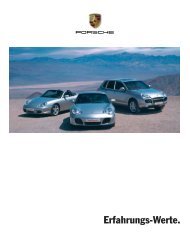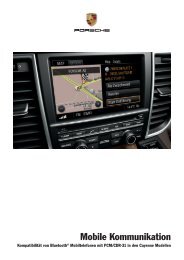Create successful ePaper yourself
Turn your PDF publications into a flip-book with our unique Google optimized e-Paper software.
1. Unscrew cap on oil filler opening.<br />
2. Top up engine oil according to the display on<br />
the multi-function display.<br />
One segment of the display corresponds to a<br />
top-up quantity of approx. 0.26 US quarts<br />
(0.25 liters).<br />
3. Carefully close cap of the oil filler opening.<br />
After opening the hood, the oil level can only<br />
be measured after driving for at least 6 miles<br />
(10 km).<br />
256 Maintenance and Car Care<br />
Oil change<br />
The engine oil has to be changed regularly at the<br />
intervals listed in your Maintenance Schedule.<br />
f Please see the chapter “FILLING CAPACITIES”<br />
on page 329.<br />
We recommend that you have the engine oil<br />
changed at your Porsche dealer, who has the<br />
required oils and the necessary filling equipment.<br />
If you suspect an oil leak in the engine have your<br />
dealer check it out immediately.<br />
All current engine oils are compatible with each<br />
other, i.e. when making an oil change it is not<br />
necessary to flush the engine if you wish to use a<br />
different brand or grade of oil.<br />
Since, however, each brand of oil has a special<br />
composition, you should, if possible, use the<br />
same oil brand if it becomes necessary to top up<br />
between oil changes.<br />
Porsche engines have long intervals between oil<br />
changes. You can make best use of these long oil<br />
change intervals by using multigrade oils since<br />
these are largely independent of seasonal<br />
fluctuations in temperature.<br />
If your vehicle is used frequently in stop-and-go<br />
traffic in cold weather, the engine will not always<br />
be properly warmed up.<br />
Condensation from products of combustion may<br />
accumulate in the oil. In this case, it is advisable<br />
to change the oil more frequently so that your<br />
engine once again has 100% efficient engine oil.<br />
Engine oil performance class<br />
Engine oil is not only a lubricant, but also serves<br />
to keep the engine clean, to neutralize the<br />
contaminants which penetrates into the engine<br />
through combustion and to protect the engine<br />
against corrosion.<br />
To perform these functions, the oil is provided with<br />
additives which have been specially developed for<br />
these functions.<br />
The efficiency of an oil is expressed, for example,<br />
by the API, ILSAC or ACEA classifications.<br />
Viscosity<br />
Like all liquids, engine oil is viscous when cold,<br />
and thin-bodied when warm. The viscosity of an oil<br />
is expressed by its SAE class. For cold viscosity<br />
(measured at temperatures below 32 °F/0 °C) the<br />
SAE class is given as a number and the letter “W”<br />
(as in winter), for hot viscosity (measured at<br />
212 °F/100 °C) the SAE class is given only as a<br />
number.<br />
The viscosity of an oil is, therefore, always the<br />
same if it has the same number of an SAE class.<br />
Oils with two viscosities are called multigrade oils;<br />
oils with only one viscosity are termed singlegrade<br />
oils.<br />
Single-grade oils can not be used in your engine.<br />
The viscosity of the engine oil for your Porsche<br />
has to be chosen according to the ambient<br />
temperature given in the engine oil<br />
recommendation table.



